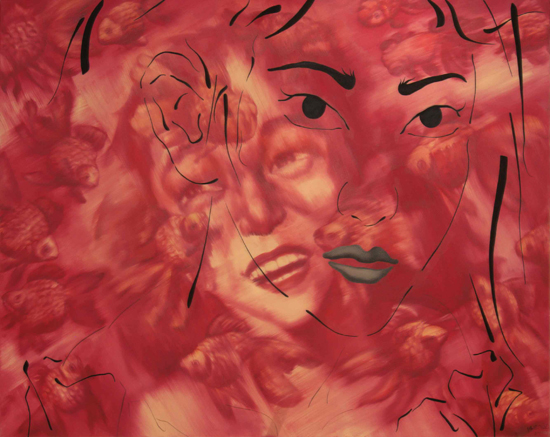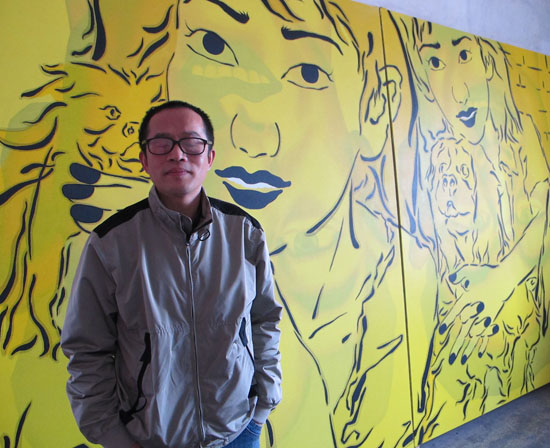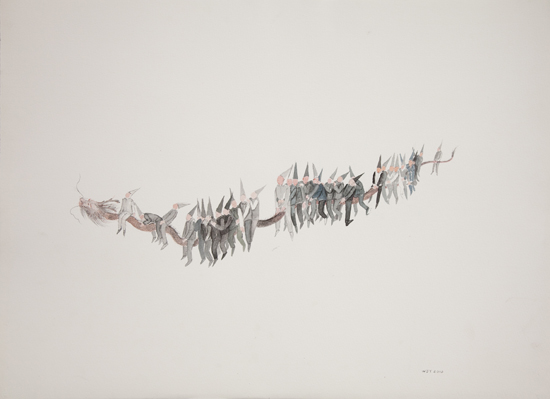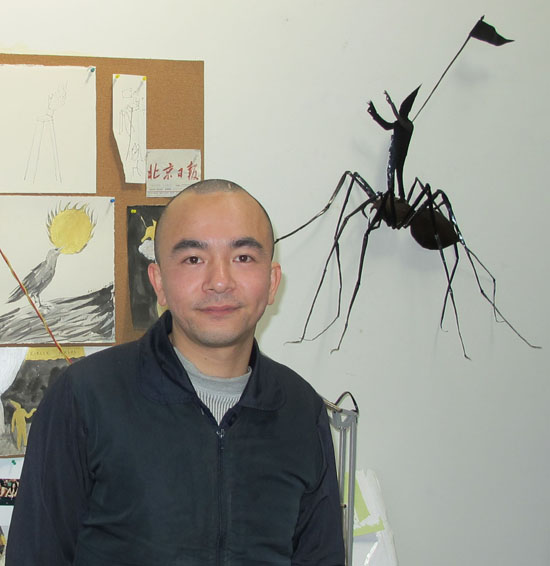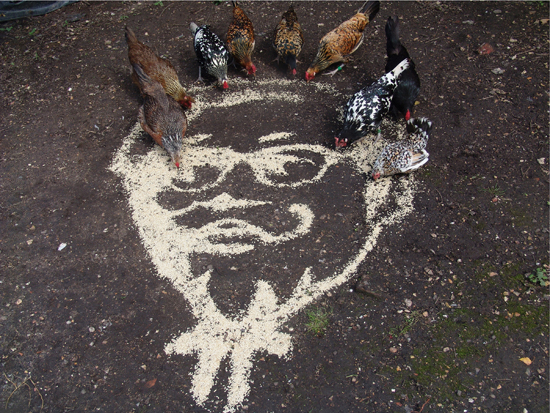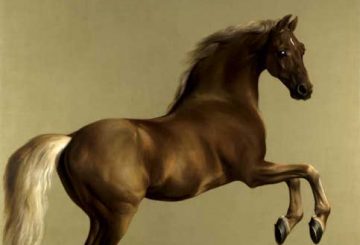From far flung exhibitions in Melbourne and China, Luise Guest works out which way is east…
Facing East at Ausin Tung Gallery in Melbourne provides further evidence, if any were needed, of China’s shift over the last fifteen years from periphery to centre, from the exotic ‘other’ to a place, as Edward Sanderson says in his catalogue essay, “on a precarious balancing point between the influx and outflow of social and culture tides.” The phrase ‘Facing East’ implies that we are here, in the hegemonic West, looking towards a far distant and exotic culture – the East of Marco Polo, perhaps, or the Forbidden City of the Qing Dynasty Emperors, or indeed the East of ‘The East is Red’. Instead, we might consider that it is we who are on the periphery, looking towards the centre. In Chinese, the word for China, ‘Zhong Guo’, means ‘Middle Earth’, centre of the known world. With the rise and rise of China, this seems to have become rather a statement of fact than a historical oddity.
Pu Jie ,’Feeding’, 2010, oil on canvas, 200 x 250cm, image reproduced courtesy of Ausin Tung Gallery.
What this might mean for people living in such a fluid and shape-shifting place is evoked in subtle ways in many of the works in the exhibition. Ausin Tung Gallery is a relatively new kid on the block, with a stated intention to raise the profile of Chinese art for Melbourne audiences, and to facilitate dialogue between Australian and Chinese artists through residencies and curated shows. In this exhibition the result is an interesting selection of works by artists who at first sight appear to have little in common. What could connect Wu Daxin’s ephemeral ice sculpture installations on the Great Wall with Wu Junyong’s dark and sardonic digital animations; or You Si’s lyrical ink abstractions with Pu Jie’s 21st century reworking of Political Pop? And yet the juxtaposition of these artists’ works, together with others by artists such as Chen Hangfeng, Miao Xiaochun, Gao Weigang, Zhang Bojun and Ren Bo, delivers an intriguing snapshot of life and art in China today. Within China there are many cultures, many histories, and many experiences, despite the tendency of some in the West to oversimplify. Artists today in China, like artists everywhere, engage in transnational and global conversations. As they say on Law and Order: “These are some of their stories”.
Pu Jie’s paintings are perhaps closest to what Western audiences might expect contemporary Chinese art to look like. Informed by the Political Pop and Cynical Realist movements of the 90s, he developed his signature technique of layered glazes and washes of paint, with one image overlaying another which is fainter, more ghostly. The artist’s intention is to represent the past underneath the present reality, stubbornly lingering behind the current world of pop culture glitz and glamour, consumer desire and material wealth. This technique, and the skill with which he manipulates sheer layers of translucent paint, become visual codes signifying the power of the past, and of memory. Sometimes the ghostly images are red-scarved Young Pioneers, or revolutionary soldiers, sometimes they are Shanghai beauties of the 1930s. The artist’s wealthy family lost everything during the Cultural Revolution, and the bitterness lingers. When I spoke with Pu Jie in his Shanghai studio last year he told me that seeing a Rauschenberg exhibition in Beijing in the 1980s was unforgettable and influential, and gave him a way of collaging apparently discontinuous narratives in order to represent the layering of memories. He says, “I want to preserve the past in my work, just like a scientific specimen”.
In works such as ‘Feeding’ and ‘Head and Her No. 2’ he reveals his own response to the juxtapositions of past and present in China today. The works are luscious, with seductive surfaces that at first appear to be slick Pop images of beautiful girls drawn with black outlines recalling calligraphy strokes in ink paintings, on fields of glowing primary colour. Yet behind the blankly beautiful linear face in ‘Feeding’ lies the nostalgic image of a pre-revolutionary Shanghai beauty, and over her, in the same misty red tones, swarm feeding goldfish. The atmosphere evoked is disturbing, suggesting that just beneath the surface of our contemporary lives lie seething darker memories, revealing what he identifies as “the conflict of all Chinese people”: the transition, sometimes painful, from one kind of society to another.
Pu Jie ,photographed in his studio, Shanghai, April 2011, photograph Luise Guest.
Similarly, Beijing-based Wu Junyong works in painting, drawing, sculpture and, most significantly, digital animation in a style based on traditional paper cutting. In this show he is represented by a series of delicate watercolours which feature his trademark dunce-hatted or hooded figures, either naked or in the universal masculine uniform of the business suit. There is also an 8 minute animation, ‘Time of Stomach’, which reveals his capacity for surreal invention, creating memorable and compelling images which are at once beautiful and bleak. It came as no surprise to me, in a conversation with the artist last year, to discover that he loves Goya. ‘Saturn Devouring One of His Sons’ has a dark kinship with many of the scenarios that emerge from Wu’s imagination. We spoke in his Beijing studio, surrounded by works in progress including a table covered in wonderfully detailed black paper cut figures of the creatures which populate his imagination. He was reluctant to concede any influences on his work from contemporary artists, but identified Pieter Breugel’s ‘The Blind Leading the Blind’ as the source of many of his ideas in the most recent works. His animations, in which tiny puppet-like men and hybrid animals drawn from Western and Chinese fairy stories, fables and folk tales are manipulated into grotesque parodies of social rituals, are reminiscent in some respects of the work of William Kentridge. Like Kentridge, Wu’s works also meld a personal visual language with a political and social imperative. His most renowned animation work, ‘When We Are Rich‘, is a savagely satirical indictment of ‘new China’ with its loss of traditional values and an obsession with the trappings of wealth and success. Living in Beijing, he says, is a constant source of inspiration for his work. He describes the city as a theatre where all the craziness of the world is on show: thieves and counterfeiters, scam artists, scholars and philosophers. In his work this cast of characters are turned into scholar cranes, black crows, spiders, elephants, horses and donkeys, in amongst the humans with all their foibles and frailties.
Wu Junyong, Dragon-boat, 2010, watercolor on Paper, 56.5x76cm, image reproduced courtesy of Ausin Tung Gallery
The purpose of art, Wu believes, is to be a thermometer, taking society’s temperature. If this is so, the diagnosis is bleak. The most frequently recurring figure in his paintings, sculptures, paper-cuts and animations is the little naked man, engaged in pointless, repetitive and often humiliating actions, wearing a tall dunce’s cap. This ‘everyman’ figure represents to the artist the animalistic, greedy and corruptible nature of man, combined with the scholar’s hat representing culture. However there are also the inescapable resonances of the humiliations visited upon ‘intellectuals’ during the Cultural Revolution. Another constant theme in Wu’s work is the ubiquity of surveillance, and in ‘Time of Stomach’ the black crow, a regular inhabitant of his world, has his head replaced by a surveillance camera, swivelling to observe the audience.
Wu Junyong in his studio, Beijing, March 2011, photograph Luise Guest.
In contrast, the abstract forms of You Si’s ink scrolls create a lyrically beautiful universe in which forms swirl and dissolve, suggestive of microscopic biological forms and of the celestial . I had recently seen small coloured works on paper by this artist at NG Art in Sydney, and previously at Art Labor Gallery in Shanghai, and had found them beautiful but somewhat repetitive. The monochromatic large works here at Ausin Tung are stronger and more interesting. Reminiscent of traditional ink paintings on rice paper, yet pushing these techniques into new territory, including the use of unconventional methods such as the use of an eye dropper to create his characteristic rounded pools of ink, You Si has developed a language of form which suggests the vastness of the universe and its infinite complexity and beauty. You’s parents were famous political poster painters during the 1960s, a uniquely Chinese artistic heritage which may have contributed to the strong graphic quality of his paintings. Travelling to live and work in New York and also in Australia during the 1980s, however, allowed him the freedom to experiment and innovate.
Wu Daxin is represented in this show by two large inkjet prints, documentation of his temporal work ‘Great Wall Project’ in which he created structures suggestive of Byzantine or Romanesque domes on the squat watchtowers at a remote area of the Great Wall, and hung them with flat panels of ice in the early morning. It recalls Goldsworthy’s ephemeral works with ice and snow as well as his drywall constructions in remote areas, but also suggests the blurring of cultural boundaries in China past and present. The wall was built to keep the invading barbarians out, and was spectacularly unsuccessful in doing so. The peculiarly evocative image of thin panels of ice slowly melting to reveal the skeletal structure of the domes can be read in many ways, not least as the endurance of Chinese culture in contrast to the transitory dominance of the European structures which were imposed on it. Wu Daxin’s ice sculpture ‘Ashley’s Heart’ is currently showing in ‘Down the Rabbit Hole’ at the White Rabbit Gallery in Sydney. Chen Hangfeng is known in Australia more for his witty ‘Logomania’ series of papercuts than for his video and multimedia works. ‘Logomania’ was the first body of work he created after giving up work as a graphic designer, and reveals his particular interest in ideas about overconsumption, materialism, and the rule of powerful global corporations, and how the use of these corporate images can be subverted to create new meanings. Ausin Tung were showing some of these works at the Affordable Art Fair in Melbourne, ironically just near a stand showing traditional Chinese folk art papercuts selling at vastly inflated prices. In ‘Facing East’ his video work ‘The Last Supper’ shows the artist drawing the KFC logo of Colonel Sanders with chicken feed on the ground, and the process of the chickens pecking away at the logo, eating the corporate image that their lives may ultimately sacrificed to. KFC, by the way, is the most successful fast food chain in China and may well have contributed to the much discussed problem of the obesity of the ‘Little Emperors’ generation of children now emerging from adolescence into adulthood.
Chen Hangfeng, The Last Supper, 2008, digital c print lambda, 73 x 54.5 cm, edition 3 of 5 1, image reproduced courtesy of Ausin Tung Gallery
Gao Weigang’s ‘Nothing Can Go Wrong’, a painting of a tiger skin with a bell attached to its tail, typifies the dark humour of much recent Chinese art. The artist, whose Beijing shows at China Art Archives were curated by Ai Weiwei, won the Art Futures Award at the 2011 Hong Kong Art Fair. It is not surprising, given the recent history of China, to discover that many Chinese artists love Breugel and Bosch: the teeming hordes of tiny figures, the appalling cruelty, the random nature of fate, these are evoked in many works, most particularly in Miao Xiaochun’s inventive and astonishing 3D computer animations, ‘Disillusion’, and ‘Restart’. His work ‘A Limited World’, based on Hieronymus Bosch and the Garden of Earthly Delights, was shown recently in ‘A New Horizon: Contemporary Chinese Art’ at the National Museum of Australia in Canberra. Originally a painter, he moved seamlessly into panoramic photographic works and more recently into computer imaging and animation, making works about the social transformation of China that are ambitious allegories of the human condition.
The photographs by Zhang Bojun, such as ‘We No. 2’, at first sight appear to be abstract compositions of tiny shapes like grains of rice or sand, but on closer inspection reveal themselves to be thousands of people whom he has photographed at Beijing’s overcrowded railway station. There are echoes here of Ai Weiwei’s 100 million sunflower seeds, and the continuing dominance of the collective identity rather than the individual. Like other shows of contemporary art from China, ‘Facing East’ deals with all the tensions of contemporary life and the uneasy relationship between past certainties and present ambiguities in a time of flux. It does so with the technical virtuosity and subtlety we have come to expect from Chinese artists.
